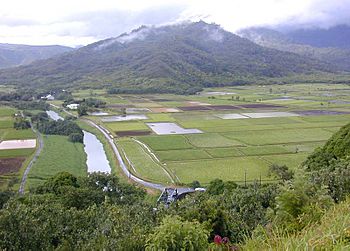Hanalei River facts for kids
The Hanalei River is a beautiful river on the island of Kauaʻi in Hawaii. It starts high up on the eastern side of Mount Waiʻaleʻale and flows north for about 15.7 miles (25.3 km). Finally, it reaches the Pacific Ocean at Hanalei Bay, forming an estuary where fresh river water mixes with salty ocean water.
Even though its watershed (the area of land that drains into the river) is not the biggest on Kauaʻi, the Hanalei River is special. It flows through some of the wettest places on Earth, where it rains more than almost anywhere else! The river drops very quickly from its starting point, which is about 3,500 feet (1,067 meters) above sea level. On average, a lot of water flows through it – about 216 cubic feet (6.12 cubic meters) every second, making it the second-largest river in Hawaii by water flow.
Quick facts for kids Hanalei River |
|
|---|---|

Lower Hanalei Valley as seen from the overlook near Princeville. Hanalei (town) is to the right.
|
|
| Country | United States |
| State | Hawaii |
| Region | Kauai |
| Physical characteristics | |
| Main source | Mount Waiʻaleʻale 22°04′32″N 159°29′34″W / 22.07556°N 159.49278°W |
| River mouth | Pacific Ocean Hanalei Bay 22°13′04″N 159°30′03″W / 22.21778°N 159.50083°W |
| Length | 15.7 mi (25.3 km) |
| Basin features | |
| Basin size | 19.1 sq mi (49 km2) |
Contents
Life in the Hanalei River
The Hanalei River is home to many different kinds of plants and animals. The lower, flatter parts of the river flow past the Hanalei National Wildlife Refuge. This special area helps protect nature. You can also see many taro farms here. Taro is a plant with a starchy root that is a very important food in Hawaii. In fact, about 60% of all the taro grown in Hawaii comes from this area!
Amazing River Animals
The Hanalei River is a great place for animals that can live in both fresh and saltwater. These are called amphidromous species. They move between the river and the ocean during different parts of their lives.
- Gobies: There are five different types of native gobies, which are small fish.
- Crustaceans: Two native species of crustaceans, like crabs or shrimp, live here.
- Hīhīwai: This is an edible snail called Neritina granosa. People have eaten these snails for a long time.
- Newcomb's Snail: In the upper parts of the river, you can find a special kind of snail called Erinna newcombi. This snail is a threatened species, meaning it's in danger of disappearing. It has adapted very well to its unique river home.
Protecting the Hanalei River
The Hanalei River is so important that it was given a special title. On July 30, 1998, US President Bill Clinton named it an American Heritage River. This means the river has important natural, historical, and cultural value. This title helps protect the river for future generations.
Historic Bridge
There is a major bridge that crosses the Hanalei River. It's still a one-lane bridge and is part of Hawaii Route 560. This bridge is so old and important that it is listed on the National Register of Historic Places listings in Hawaii. This list includes places that are important to the history of the United States.

